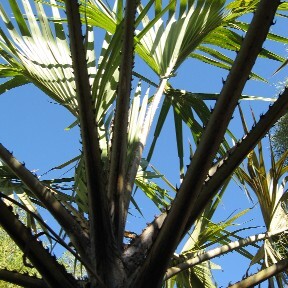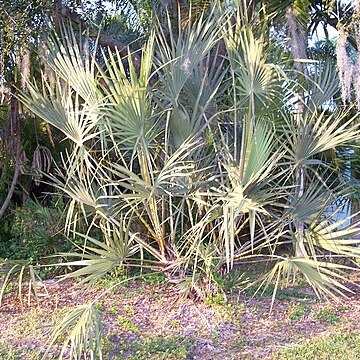Clustering or solitary palm, occasionally already mature while still a rosette, tending to form shrubby thickets with decumbent trunks, rarely more than 5 m. tall and very rarely tree-like.. Stems suckering, hence building up clumps of uneven aged trunks; dichotomizing once or twice, rarely more, when engulfed by sand dunes the dichotomies close, producing a clump of crowns on the surface of the dune; stems grey, to 25 cm. in diameter, usually less, usually covered by long-persistent leaf-bases, occasionally destroyed by fire, leaving very close leaf-scars.. Crown consisting of 8–15 green leaves; petiole to 70 cm. long, often much shorter, to 3 cm. wide, widening at the very base, the triangular cleft ± 20 cm. long; petiole greyish green, armed throughout its length with distally pointing black triangular spines to 1 cm. long and rich brown scales and thin to very dense wax, especially when young; hastula regular or very asymmetrical. Lamina strongly costapalmate, the costa 30–80 cm. long, usually curved, grey-green to very glaucous, with a dense covering of wax in young leaves especially in sand dune forms, and scattered black scales; lamina divided to 1/2 the radius in mid-leaf, to 3/4 radius near the edge, into 15–20 segments, to 3.5 cm. broad, rather stiff, rarely exceeding 40 cm. long.. Male inflorescence to 1 m., pendulous or arching with 5–7 partial inflorescences; peduncle ± 3 cm. in diameter; peduncular bracts ± 20 cm. long, covered in abundant brown hairs and white wax; rachillae 1–3 in a group, slender, rarely exceeding 15 cm. long by 0.7 cm. wide; rachilla-bracts 1 mm. high by 4 mm. wide, exposed at anthesis.. Male flowers with sepals very narrow, ± 3 mm. long by 0.5 mm. wide; corolla stalk ± 2 mm. long, the lobes somewhat spathulate, 3 mm. long by 1.5 mm. wide; filaments ± 2 mm. long, anthers ± 1.5 mm. long, bright yellow.. Female inflorescence as the ♂, but rachillae usually 1–2 only in each partial inflorescence; pits ± 4 × 7 mm. at anthesis.. Female flower with pedicel ± 3 mm. long by 1.5 mm. wide at anthesis; sepals and petals similar, ± 2 mm. long by 2 mm. wide at the base, triangular; ovary bright green, ± 2 mm. in diameter.. Fruit extremely variable in size and shape, from ovoid and pyriform to extreme, cottage-loaf shaped, rarely 6 cm. long and 4 cm. wide at the apex, usually much less and occasionally as small as 3 × 2.5 cm., usually with a distinct ridge on one side, and a distinct widening toward the apex, the epicarp generally matt or very finely dimpled, without prominent warts or pockmarks, pale green when immature, ripening mid to dark brown; mesocarp ± 4 mm. thick, faintly aromatic, dark brown; endocarp ± 3 mm. thick except at the apical pore.. Seed somewhat polyhedral, conforming to the shape of the endocarp; endosperm ± 5 mm. thick.. Figs. 3/3, (p. 25), 4 and 5 (p. 32).
More
A dwarf branched palm. It only branches slightly. It can grow 10 m high. The stem is usually covered with the old leaf bases. The crown is fairly small. The leaves are grey-green, deeply divided and fan shaped. The fruit are pear shaped. They have distinctly narrowed bases. The fruit are drier and smaller than Hyphaene thebaica. They are brown when ripe and about 5 cm long. They have a thin layer of edible flesh.
Plant forming dense, low clumps or otherwise a tree, up to 9 m high. Leaves fan-shaped, grey-green. Fruit hard, shiny, dark brown, up to 63 mm in diameter, often like short, fat pears in shape.



